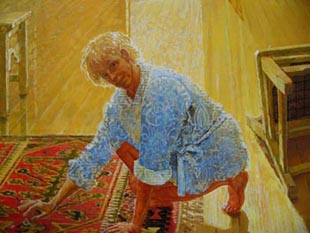Traditionally, a painter has been identified with a style. Heinrich Wofflin examines this phenomenon in Principles of Art History, where he breaks style into polar dichotomies (as Berenson later did) and emphasized, as Berenson did, ethnicity or hometown as an explanation for inclinations of style. After Malraux's realization that global art is available to all artists, the provincial lineages that organized the study of style broke down as all artists, through the availability of reproductions, could be exposed to art of any place or time as they chose. Meyer Schapiro regards style as that which is constant in form or expression throughout the productions of an artist or a culture.
 This
argues for unconscious style, and I believe that while the creation of
style was important in the modernist agenda, modernist style had two manifestations:
an explicit style (the project, the constructed intentional style) and
an implicit style (the involuntary style as described by Wofflin or Berenson
through comparing and contrasting cultural and/or formal approaches into
polarities (e.g. tectonic vs a-tectonic, Florentine vs Venetian - more
or less: maniera). In the postmodern world, the project moves in the direction
of astylism, but unconscious biases still exert power over outcomes. According
to this view, Kiefer would be still a late modernist painter while mid-eighties
David Salle a postmodernist. When
Peter Schjeldahl says that "painting is embarrassingly overqualified for
how we consume visual material in our culture" he is subtly implying that
painting itself occupies a sidestream to postmodern development. Further,
when he says," Painting is the unbeatable example of and metaphor for
individual consciousness," Schjeldahl indicates that painting, by its
nature, is congenitally disinclined to get with the "there-is-no-author"
program, as painting registers individuality automatically. It is because
of its inherent registering of individuality, not because it has "run
out of things to say," that painting is regarded as dead by postmodernist
critics. Painting isn't dead, it is simply dead to the postmodernist
agenda which wishes to emphasize other things that art might be. Whatever
vitality that postmodern painting may have is due to the frisson of inevitable
individuality with an agenda that denies it.
This
argues for unconscious style, and I believe that while the creation of
style was important in the modernist agenda, modernist style had two manifestations:
an explicit style (the project, the constructed intentional style) and
an implicit style (the involuntary style as described by Wofflin or Berenson
through comparing and contrasting cultural and/or formal approaches into
polarities (e.g. tectonic vs a-tectonic, Florentine vs Venetian - more
or less: maniera). In the postmodern world, the project moves in the direction
of astylism, but unconscious biases still exert power over outcomes. According
to this view, Kiefer would be still a late modernist painter while mid-eighties
David Salle a postmodernist. When
Peter Schjeldahl says that "painting is embarrassingly overqualified for
how we consume visual material in our culture" he is subtly implying that
painting itself occupies a sidestream to postmodern development. Further,
when he says," Painting is the unbeatable example of and metaphor for
individual consciousness," Schjeldahl indicates that painting, by its
nature, is congenitally disinclined to get with the "there-is-no-author"
program, as painting registers individuality automatically. It is because
of its inherent registering of individuality, not because it has "run
out of things to say," that painting is regarded as dead by postmodernist
critics. Painting isn't dead, it is simply dead to the postmodernist
agenda which wishes to emphasize other things that art might be. Whatever
vitality that postmodern painting may have is due to the frisson of inevitable
individuality with an agenda that denies it.
|
Coyote
in the Kitchen, detail, 78 x 81, 2001
|
Nevertheless, from Early Renaissance to Abstract Expressionism, "signature style" was historically regarded as both automatic and desireable. It is by the style that the artist is determined, and while iconographic analysis is of great value, it is through delectation that artists are identified. Anomolies are interesting, the first of these being states of indistinguishability, which may have been commonplace in cultures that de-emphasize the individual (e.g. ancient Egypt, for instance, in which distinctions may be excruciatingly slight) but are rare in the post-Renaissance West until the peculiar period in which analytical cubist paintings of Braque and Picasso seem to intend, if not fully achieve, indistinguishability. With mechanical reproduction we see duplicability, but not indistinguishability. There are attempts at indistinguishability through joint participation in the artwork (Equipo 57, for instance) but Braque and Picasso's near indistinguishability take the heady joy of being part of a movement (the Impressionists, for instance) and drive it into a psychological experience for both artists that suggests extreme intimacy. As Picasso calls him: "Braque, my wife." But the situation suggests something different than either the differentiated but bonded autonomies of a "healthy relationship" or the "enmeshment" of an unhealthy one. It does resemble a short period during which Sun studios brought together Elvis, Roy Orbison, the Everly Brothers and Jerry Lee Lewis in a pressure cooker that rapidly developed the language and parameters of basic Rock'n'Roll, the way Picasso and Braque rapidly generated the language and parameters of Cubism.
- more
